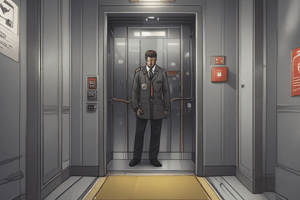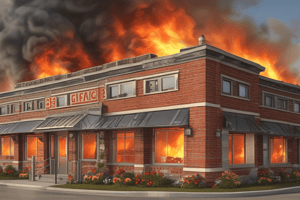Podcast
Questions and Answers
What is the primary responsibility of each driver during an emergency response?
What is the primary responsibility of each driver during an emergency response?
- To maintain communication with the Communication Center
- To ensure that all personnel are wearing a seat-belt (correct)
- To familiarize themselves with the incident location
- To ensure all equipment is ready for use
What action should be taken regarding vehicle lights and sirens at large, heavily blocked intersections?
What action should be taken regarding vehicle lights and sirens at large, heavily blocked intersections?
- Increase speed to clear the intersection quickly
- Maintain normal operations regardless of traffic conditions
- Always keep sirens active to alert civilian vehicles
- Turn off lights and sirens to prevent accidents (correct)
Under what circumstance is an emergency response warranted?
Under what circumstance is an emergency response warranted?
- When there are no personnel available for assignments
- When there is a minor traffic incident reported
- When the weather conditions are severe
- When there is an immediate threat to life safety and/or property (correct)
What should the first arriving unit consider when advising other responding units?
What should the first arriving unit consider when advising other responding units?
During an emergency response, what is the expected action regarding vehicle's visual and audible warning devices?
During an emergency response, what is the expected action regarding vehicle's visual and audible warning devices?
What is the primary responsibility of all Emergency Operations personnel during an incident?
What is the primary responsibility of all Emergency Operations personnel during an incident?
What should a Company Officer do when self-assigning to an incident?
What should a Company Officer do when self-assigning to an incident?
What is the ultimate goal when responding to emergency incidents according to the procedures?
What is the ultimate goal when responding to emergency incidents according to the procedures?
What must be obtained before self-assigning to an incident during a multi-company response?
What must be obtained before self-assigning to an incident during a multi-company response?
What is the appropriate response code for a medical incident?
What is the appropriate response code for a medical incident?
In what scenario should a Code 1 response be initiated instead of Code 3?
In what scenario should a Code 1 response be initiated instead of Code 3?
Which type of request is classified as non-emergency assistance?
Which type of request is classified as non-emergency assistance?
What should be done if new information changes the call type of an incident?
What should be done if new information changes the call type of an incident?
When should responding units upgrade their response to Code 3?
When should responding units upgrade their response to Code 3?
Which incident requires a Code 3 response by both the Engine and Brush Truck?
Which incident requires a Code 3 response by both the Engine and Brush Truck?
What is the expected response strategy for a dumpster/trash fire with no exposures reported?
What is the expected response strategy for a dumpster/trash fire with no exposures reported?
Which of the following conditions requires a Code 3 response, regardless of other circumstances?
Which of the following conditions requires a Code 3 response, regardless of other circumstances?
Which situation does NOT authorize the use of emergency lighting and audible warning devices?
Which situation does NOT authorize the use of emergency lighting and audible warning devices?
What should fire personnel do if they encounter an unrelated incident while en route to a call?
What should fire personnel do if they encounter an unrelated incident while en route to a call?
What is the primary role of the Fire Operations Officer during non-emergency requests?
What is the primary role of the Fire Operations Officer during non-emergency requests?
How should the response code change if a new call type requires a priority change?
How should the response code change if a new call type requires a priority change?
For which of the following incidents is a Code 1 response required before a potential upgrade to Code 3?
For which of the following incidents is a Code 1 response required before a potential upgrade to Code 3?
Flashcards
Code 3 Response
Code 3 Response
A designated response where units use all available warning devices and proceed with urgency to an emergency incident.
Code 1 Response
Code 1 Response
A response where units are dispatched to an emergency incident but proceed with less urgency, often using reduced warning signals or no sirens.
Staging
Staging
A designated location where units wait for further instructions or await deployment to an emergency incident.
Slow to Code 1
Slow to Code 1
Signup and view all the flashcards
Continue a Code 3 Response
Continue a Code 3 Response
Signup and view all the flashcards
Non-Emergency Response
Non-Emergency Response
Signup and view all the flashcards
Officer Discretion
Officer Discretion
Signup and view all the flashcards
Seatbelt Responsibility
Seatbelt Responsibility
Signup and view all the flashcards
Emergency Response
Emergency Response
Signup and view all the flashcards
Designated Response
Designated Response
Signup and view all the flashcards
Call Type Change
Call Type Change
Signup and view all the flashcards
Medical Incidents
Medical Incidents
Signup and view all the flashcards
Residential Structure Fire (11R)
Residential Structure Fire (11R)
Signup and view all the flashcards
Commercial Structure Fire (11C) or High-Rise Structure Fire (11H)
Commercial Structure Fire (11C) or High-Rise Structure Fire (11H)
Signup and view all the flashcards
Wildland Fire (14 / 14D)
Wildland Fire (14 / 14D)
Signup and view all the flashcards
Small LP Leak without Fire (19), Fuel Leak (41), Chemical Emergency (47), Car in Canal (494)
Small LP Leak without Fire (19), Fuel Leak (41), Chemical Emergency (47), Car in Canal (494)
Signup and view all the flashcards
Fights, Assaults, Domestic Disputes, Attempted Suicides
Fights, Assaults, Domestic Disputes, Attempted Suicides
Signup and view all the flashcards
Shootings and Stabbings
Shootings and Stabbings
Signup and view all the flashcards
911 Hang-ups and Simultaneously Activated Intrusion and Fire Alarms
911 Hang-ups and Simultaneously Activated Intrusion and Fire Alarms
Signup and view all the flashcards
Encountering an Unrelated Incident
Encountering an Unrelated Incident
Signup and view all the flashcards
Public Assist (59)
Public Assist (59)
Signup and view all the flashcards
360-Degree Size Up
360-Degree Size Up
Signup and view all the flashcards
Study Notes
- Purpose: Establish procedures for emergency and non-emergency responses.
- Authority: Fire Rescue Administrator
- Scope: Applies to all Emergency Operations personnel.
- Personnel Responsibilities: Remain ready, move quickly to vehicles safely, follow all safety guidelines.
- Seatbelts: Drivers ensure all personnel wear seatbelts during transport.
- Emergency Response Procedure:
- Use warning devices (visual and audible) for vehicular and pedestrian safety.
- Turn off wig-wag lights at night to avoid blinding oncoming traffic.
- Use low-beam headlights.
- Driving into oncoming traffic is a last resort, use extreme caution.
- Approach large, heavily blocked intersections with caution, consider turning off lights/sirens to avoid forcing vehicles.
- Monitor radio channels for information prior to arrival.
- Emergency response triggered by a notification of immediate life/property threat.
- Responding Units:
- First arriving unit may advise others to continue or slow response or proceed to staging.
- Company officers may self-assign if it's in the best interest of the incident, communicate intent and justification to the Communication Center.
- Chief officers may respond to selected incidents.
- Vehicles for code 3 responses must have appropriate lighting, equipment, and markings.
- Non-Emergency Response:
- Non-emergency response when no immediate threat to life or property.
- Second-due units may respond to non-emergency situations for certain situations in emergencies.
- Public Assists are non-emergency requests.
- Do not use warning devices when responding to a non-emergency. Obey all driving rules.
- Forward public requests to the Fire Operations Officer for determination on response and communication of delay reasons.
- Designated Response Codes:
- Personnel must know response code for the incident.
- Local knowledge may upgrade or downgrade response. Notify Communication Center of changes.
- Dispatch supervisor ensures call type changes are relayed to responding units.
- Specific Incident Response Codes:
- Medical: Code 3 response, slow second-due units to Code 1.
- Structure Fires: Residential (11R): Code 3, "nothing showing" indicates automatic slowdown. Commercial/high-rise (11C/11H): Code 3, slowdown once no fire.
- Brush Trucks: Respond with the accompanying apparatus code to increase water supply during structure fires. Light and Air, reservist canteen respond Code 1.
- Wildland Fires: (14): Code 3 during regular season, Code 3 (14D) during dry season. Other units respond Code 1 unless life safety concerns, threatened structures, or extreme weather.
- Other Incidents: Numerous examples given for Code 1 and Code 3 response priorities for various incident types.
- Law Enforcement Incidents:
- Fights, assaults, and domestic situations begin Code 1, upgrade to Code 3 after Law Enforcement has secured the scene.
- Shootings/stabbing: Code 1 response to staging; upgrade to Code 3 after Law Enforcement secures scene
- 911 hang-ups, active alarms: consider Law Enforcement matters. Fire personnel should stage.
- Unrelated Incidents:
- Perform 360-degree size-up, immediately contact Communication Center for assistance, choose to respond to original or new incident, secure scene and provide aid (to level of training) for any Fire Rescue personnel who respond to a new incident.
Studying That Suits You
Use AI to generate personalized quizzes and flashcards to suit your learning preferences.
Description
This quiz covers the Standard Operating Guidelines for Palm Beach County Fire Rescue regarding emergency and non-emergency responses. It includes procedures, personnel responsibilities, and safety measures for effective and safe operations. Test your knowledge on emergency vehicle operations and response protocols.




